You’d think that a topic titled How to Properly Lube a Baitcast Reel would be easy to explain to folks, but actually it can create some hot debates among my angler friends, especially when taking into account the various reel types there are, selecting a lubrication product from the huge assortment of products, then deciding how far into the reel parts you want to lubricate. However, for this article I’m only going to recommend when and how to properly lube a baitcast reel between their professional full servicing. I’m not going to explain how to disassemble the whole reel and lubricate every internal component. At this point, I’ll be simply remove the spool but not go into detail on every internal part and the type of lubricant to put on each of them.
Types of Reel Servicing Lubricants
First, we’ll consider the different types of oils and lubrications available. Then discuss when to use which type of lubricant on a particular part. In general, I like to use Ardent™ reel servicing and maintenance products. I am not a supplier of Ardent™ and I believe I am unbiased. (In my blog How To Maintain and Store Your Fishing Reels Between Trips, I recommend Ardent Reel Guard Corrosion Inhibitor for between-reel servicing to keep the reel safe from corroding. You might want to read that blog for more information.) I will also talk about a few other maintenance lubrication brands for comparison.
Ardent Reel Butter Bearing Lube
Ardent Reel Butter® Bearing Lube uses the latest in lubrication engineering technology to help Properly Lube a Baitcast Reel. It penetrates deep into ball bearings and roller bearings for a complete flush of dirt and foreign debris, as well as a thorough lubrication. Unlike graphite-based lubrication, Reel Butter® Bearing Lube Contains no tiny graphite particles that produce bearing noise and can cause performance issues. Reel Butter® Bearing Lube provides maximum lubrication and corrosion protection for all bearing applications.
Ardent Reel Butter Oil, Multi-use
This product is a high-performance synthetic lubricant that is specifically designed for use on fishing reels. Ardent Reel Butter Oil penetrates critical components like bearings, shafts, and wear points. Plus, it has extremely high surface tension to reduce wear and noise, which will help you Properly Lube a Baitcast Reel.
Ardent Reel Butter Grease
Another excellent high-performance synthetic product also designed for fishing reels, Ardent Reel Butter Grease protects components long after the competition’s products have broken down. It prevents plus it easily bonds to all the working parts of any model fishing reel to help you Properly Lube a Baitcast Reel.
Shimano Bantam Oil
While this isn’t the easiest oil to find and purchase, you’ll recognize the 4.5 gram bottle if you’re a Shimano reel owner. Description: Oil for ball bearings on bait casting reels, roller clutches, spool shafts on spinning reels. This is the basic Shimano reel oil. It has relatively low viscosity and your Shimano will perform great with this basic oil.
ReelX Oil - Multi-use
ReelX® is a hi-tech, extreme-pressure-optimized reel lubricant that virtually eliminates wear, disrupts existing corrosion, and prevents new corrosion or rust from forming. ReelX can be used for both spinning and casting reels. Described by ReelX as a “breakthrough” lubricant with “core Polar Bonding technology”, it contains extreme-pressure additives specifically engineered to make your fishing reels achieve their ultimate performance.
ReelX Grease
ReelX® Grease is the new, hi-tech, synthetic, extreme-pressure optimized reel grease developed for all spinning and casting reels. Used in conjunction with ReelX® fishing reel oil, ReelX Grease blocks moisture intrusion, reduces wear, disrupts existing corrosion, and prevents new corrosion or rust from forming.
Cal’s Universal Reel & Star Drag Grease
Cal’s Universal Reel & Star Drag grease is the result of decades of hands-on fishing and reel customization experience combined with ultra-modern lubrication technology, including PTFE and polymers. It offers salt-water corrosion protection on all metals, including aluminum, steel, and brass. It is safe use on anodized and plated surfaces, all common plastics, drag materials, seals, and o–rings used in reels. Offers baby skin smooth, ultra-consistent star drag performance and superior resistance to heat and breakdown in drags and reels (Dropping point is >500°F!), plus reduced gear-drive friction for easier cranking, and minimal grease “creep” so it stays where you put it.
Lubricating the Reel
So now that you know about a couple of reel servicing lubricants on the market, I’ll describe which ones to use for each friction point to properly lube a baitcast reel and how often you need to lubricate them.
The first parts I always lubricate on my baitcast reel are near the spool which is easy to do. There are several friction points in this area to lubricate. The bearings are the most obvious. Typical bait cast reels have two bearings in the baitcast spool but may also have three. Since these are the bearings that you want to have spin as fast as possible, you should use an ultra-low viscosity oil such as Ardent Reel Butter Bearing Lube or ReelX Oil from CorrosionX. For this, you need to take off the reel side plate. (You’ll remove the spool tensioner knob in a later step.) Use the oil sparingly! One drop for each bearing. Putting too much oil on the bearings can defeat the purpose and cause the oil to build up!
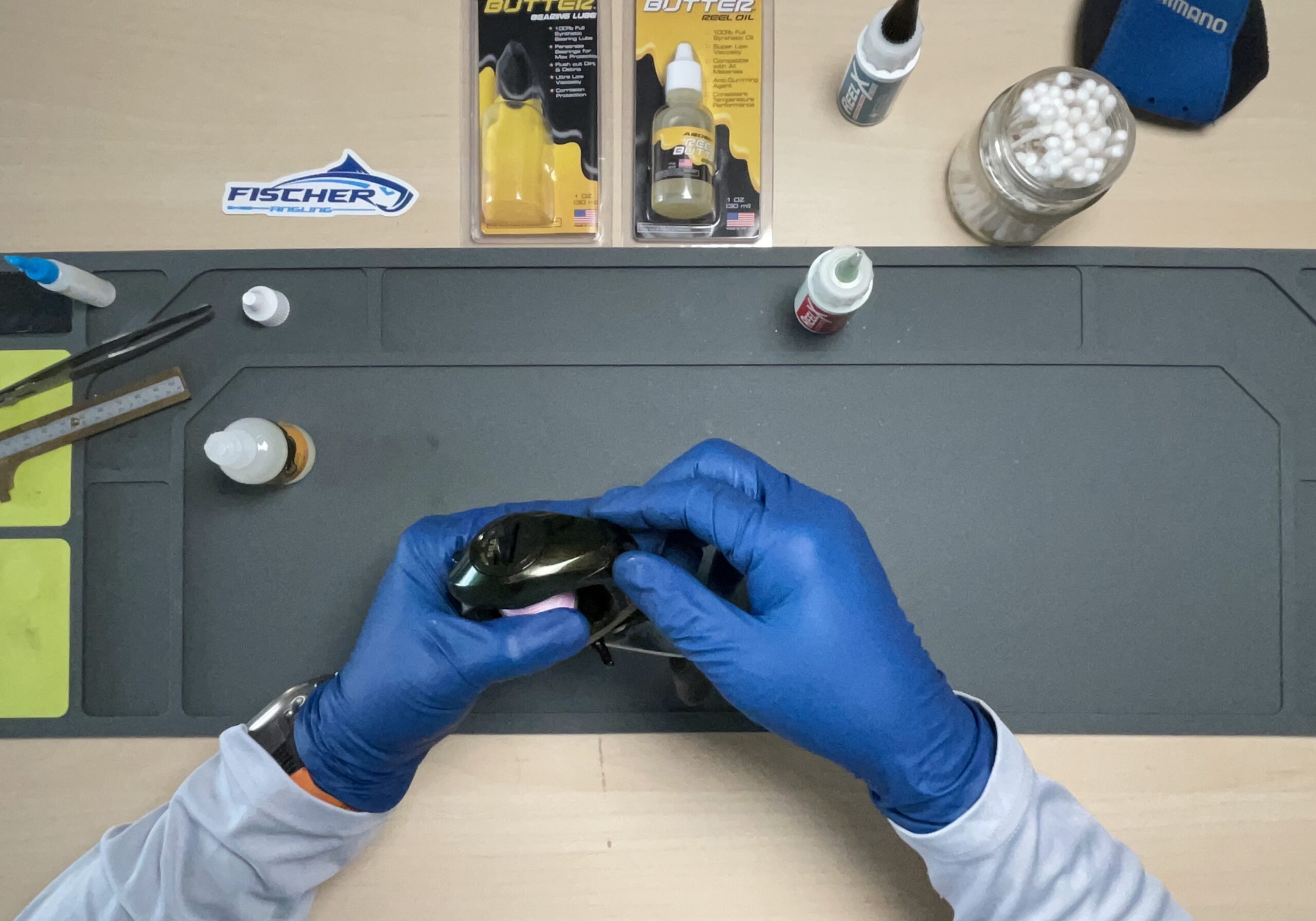
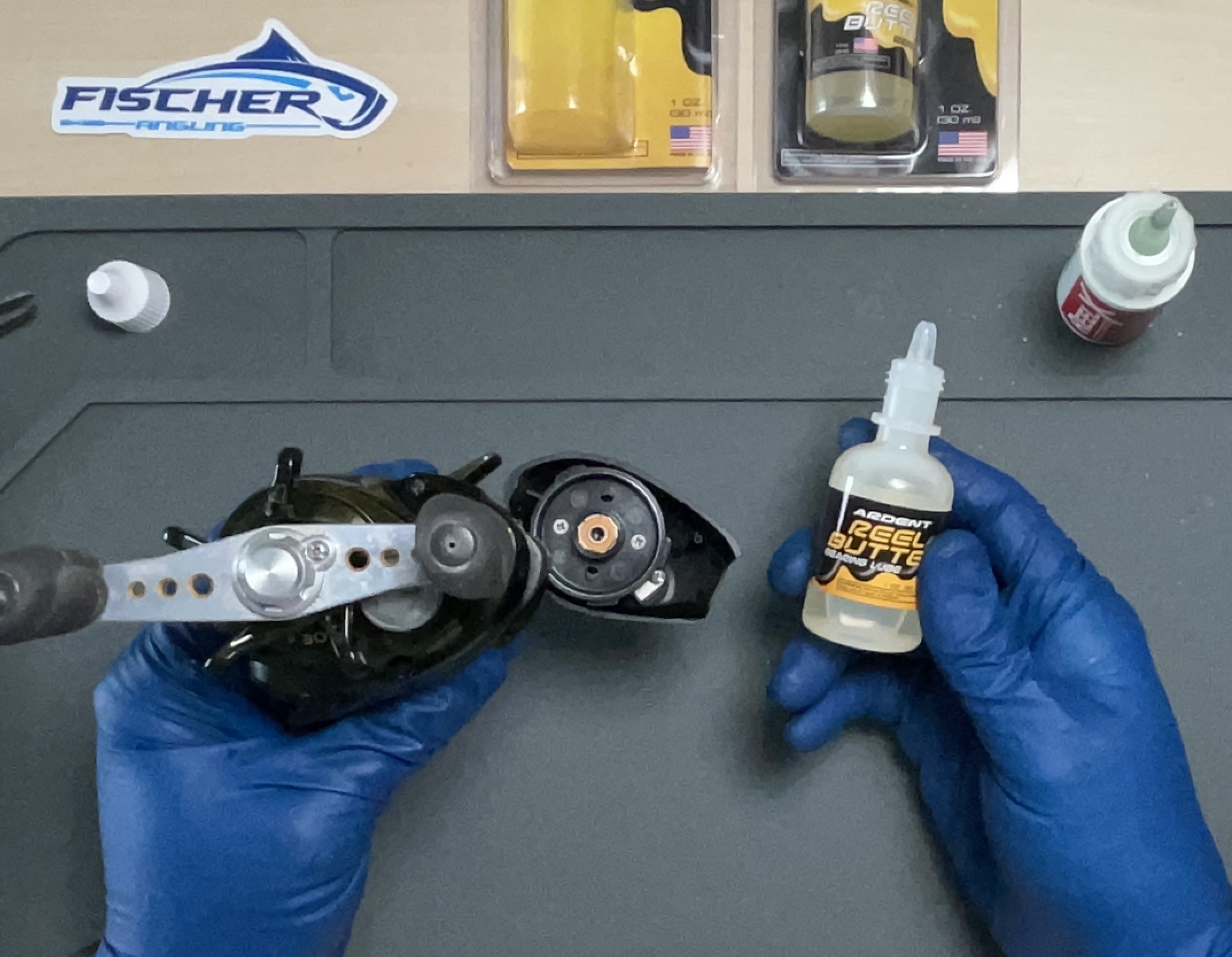
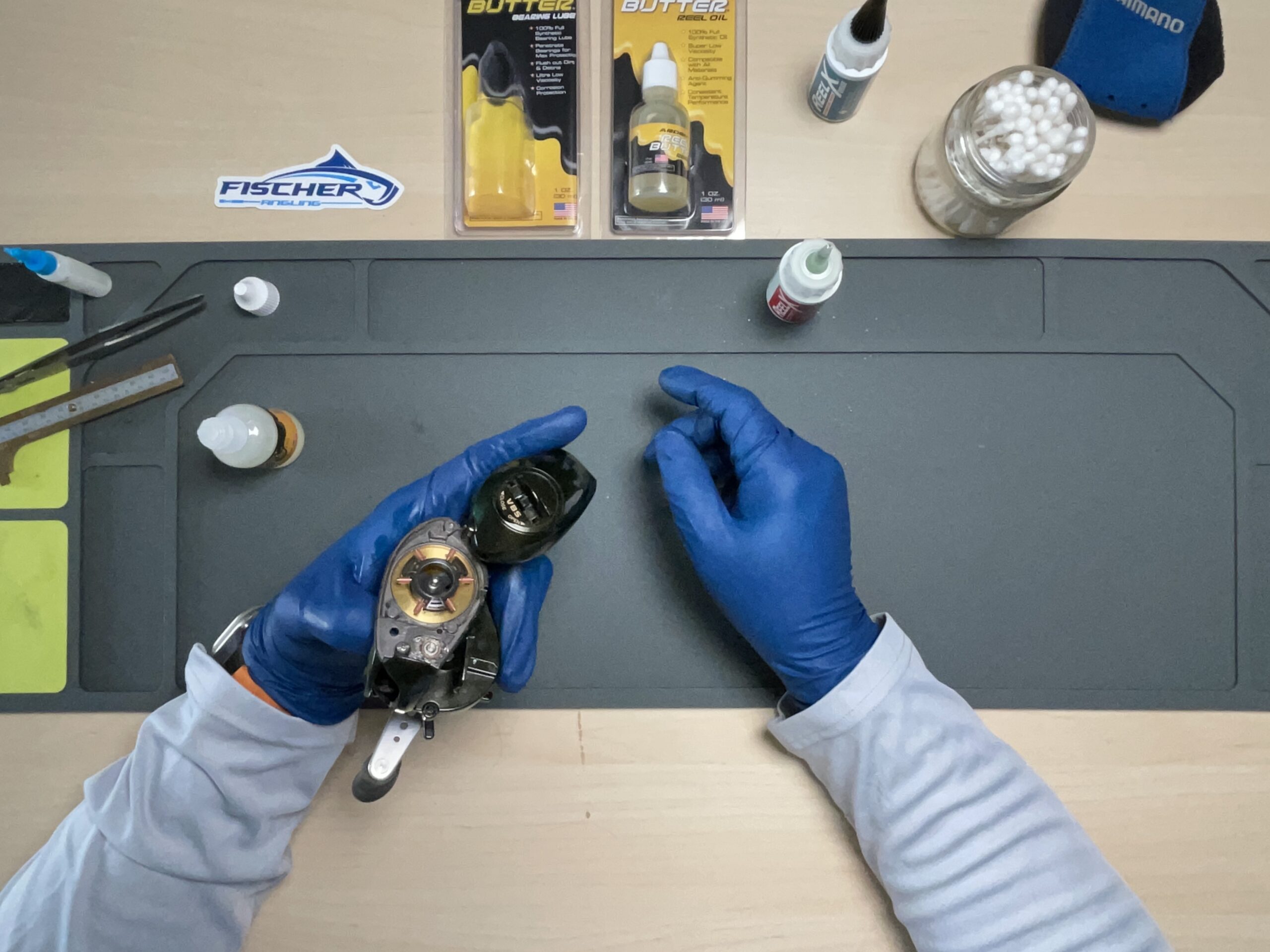
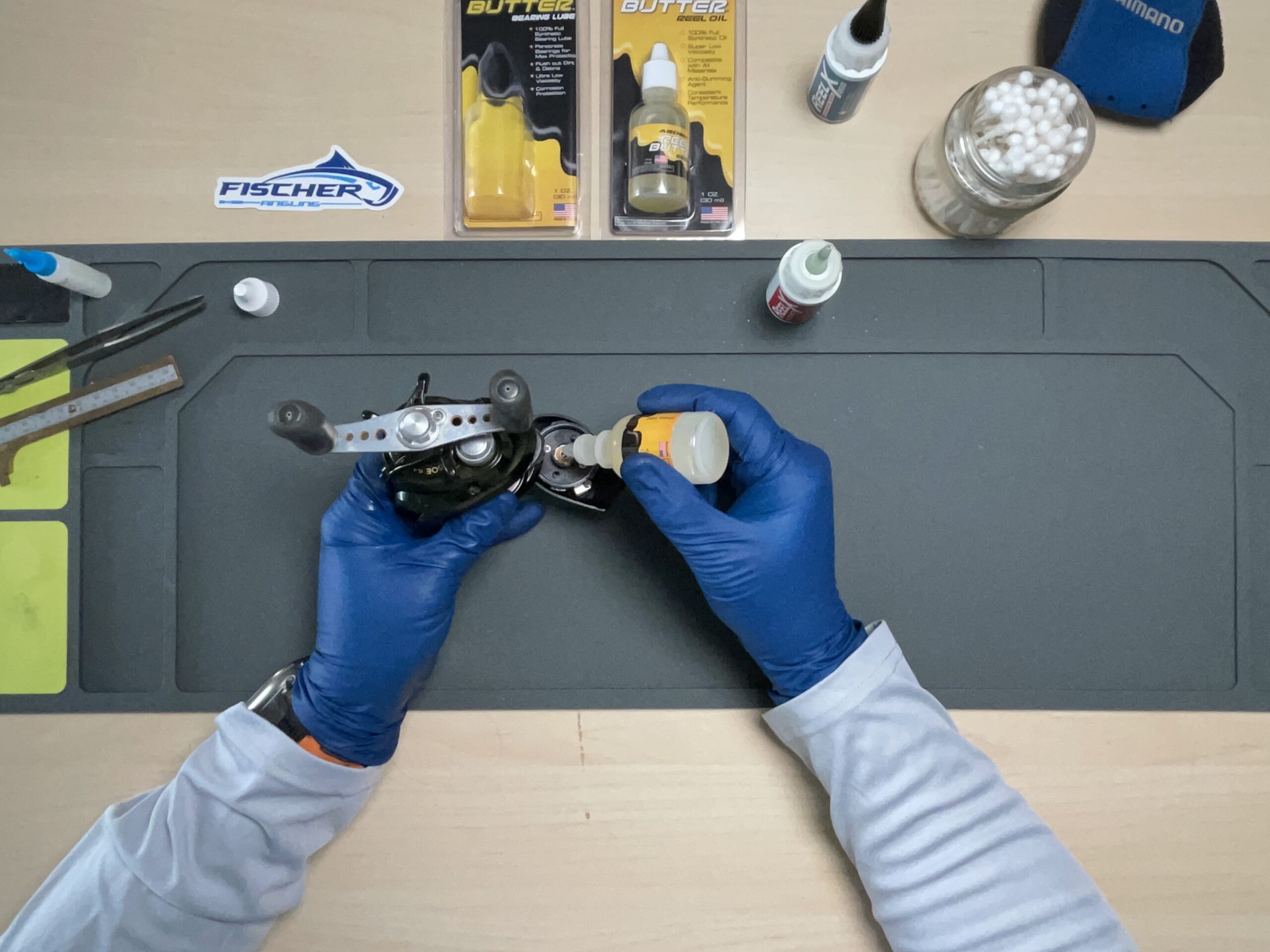
The next points to lubricate are also done with the side plate off and the spool removed. You'll need to use a Q-tip or small piece of cotton here. First, place a couple drops of oil on the Q-tip. Next, run the Q-tip along the brake case (located on the side plate). The spool brakes lightly touch the brake case when you cast so you want them to run smoothly. Once that’s done, move to the spool and run the Q-tip along any area where it touches the body of the reel. I also like to lubricate the areas between the brake collars on the spool. Once the spool has been lubricated, run the Q-tip on the body of the reel any place where the spool touches it.
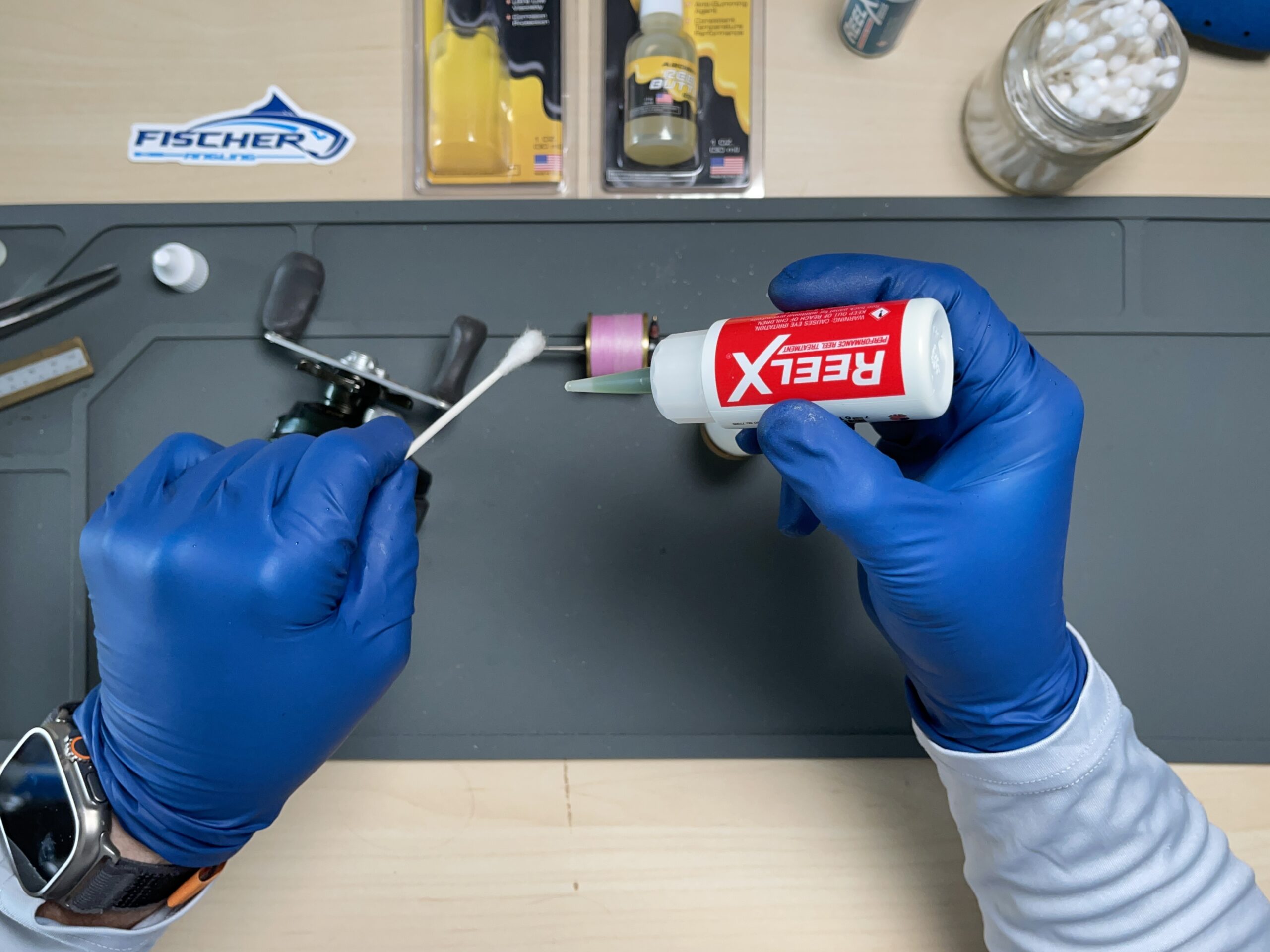

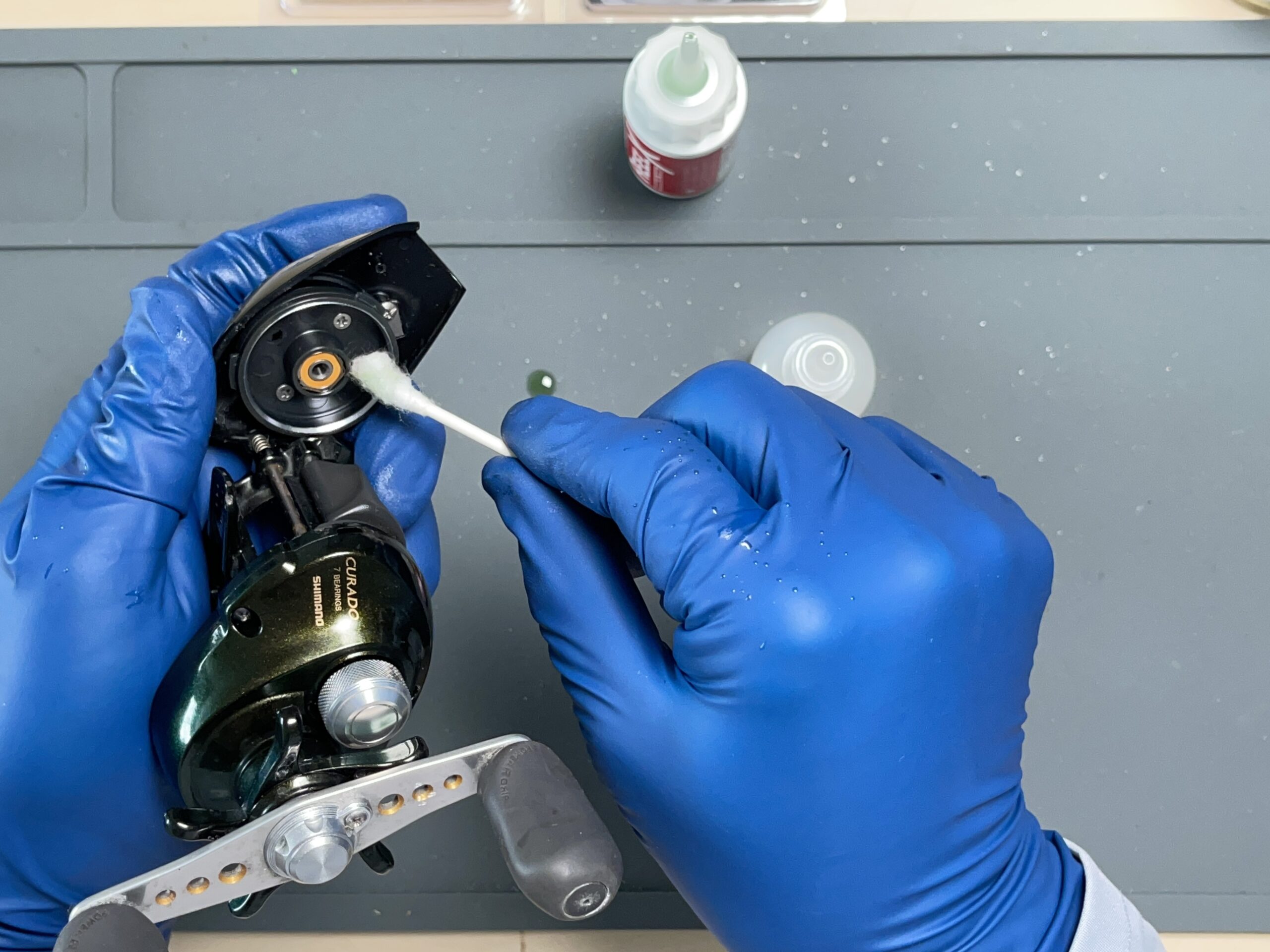

Pinion Bearing
While I have the spool out I also like to put a drop of oil on the pinion bearing. The pinion bearing is inside the reel where the spool enters the body. (You will be able to see the pinion bearing on most reels when the spool is out.) Now, install the spool back in the reel and put the side plate back on. I recommend lubricating the pinion bearing and these other parts every time you oil the side plate bearing. For me, this is after each fishing trip if I’ve been in saltwater and after 2-3 trips if in freshwater.
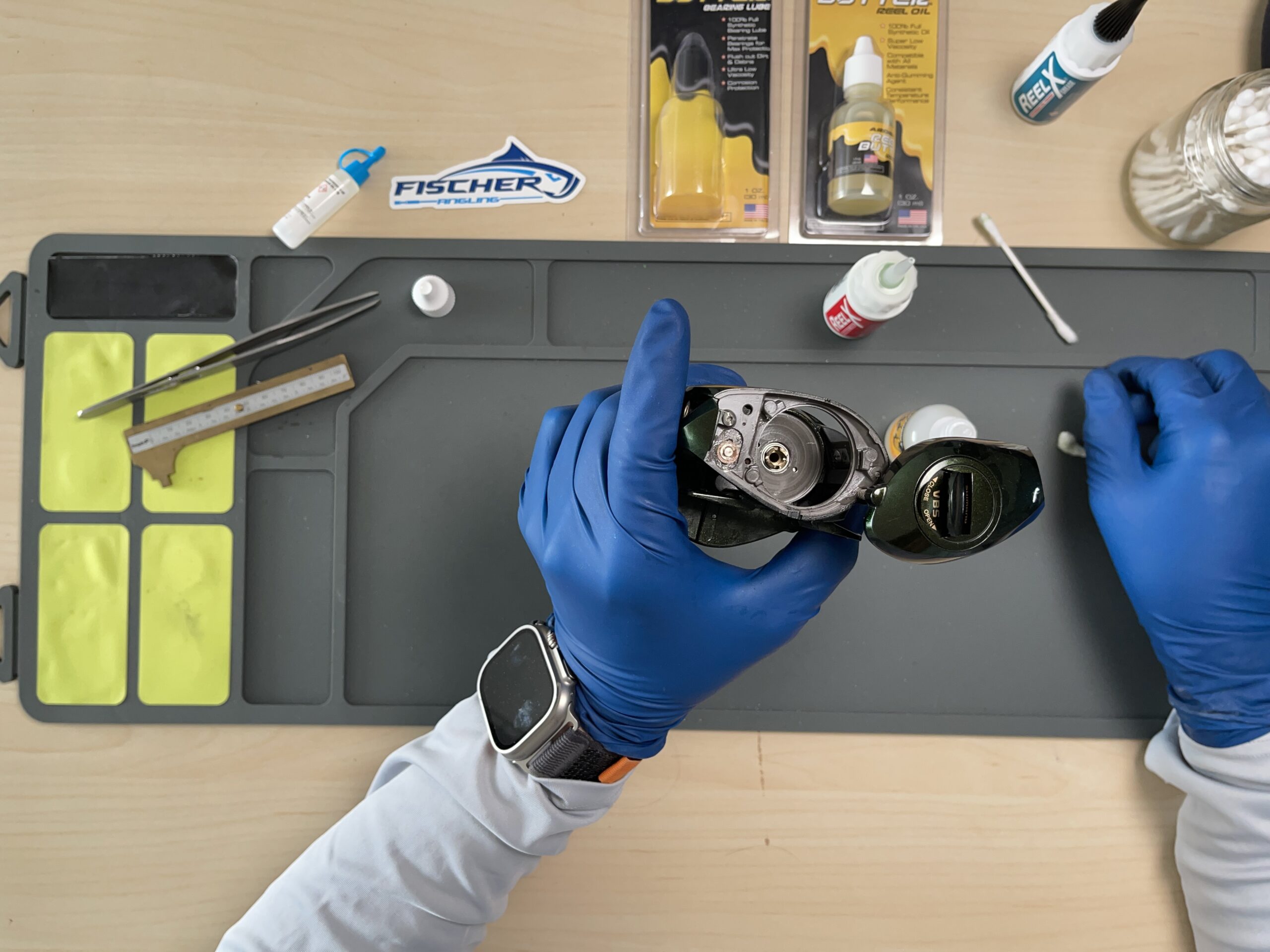
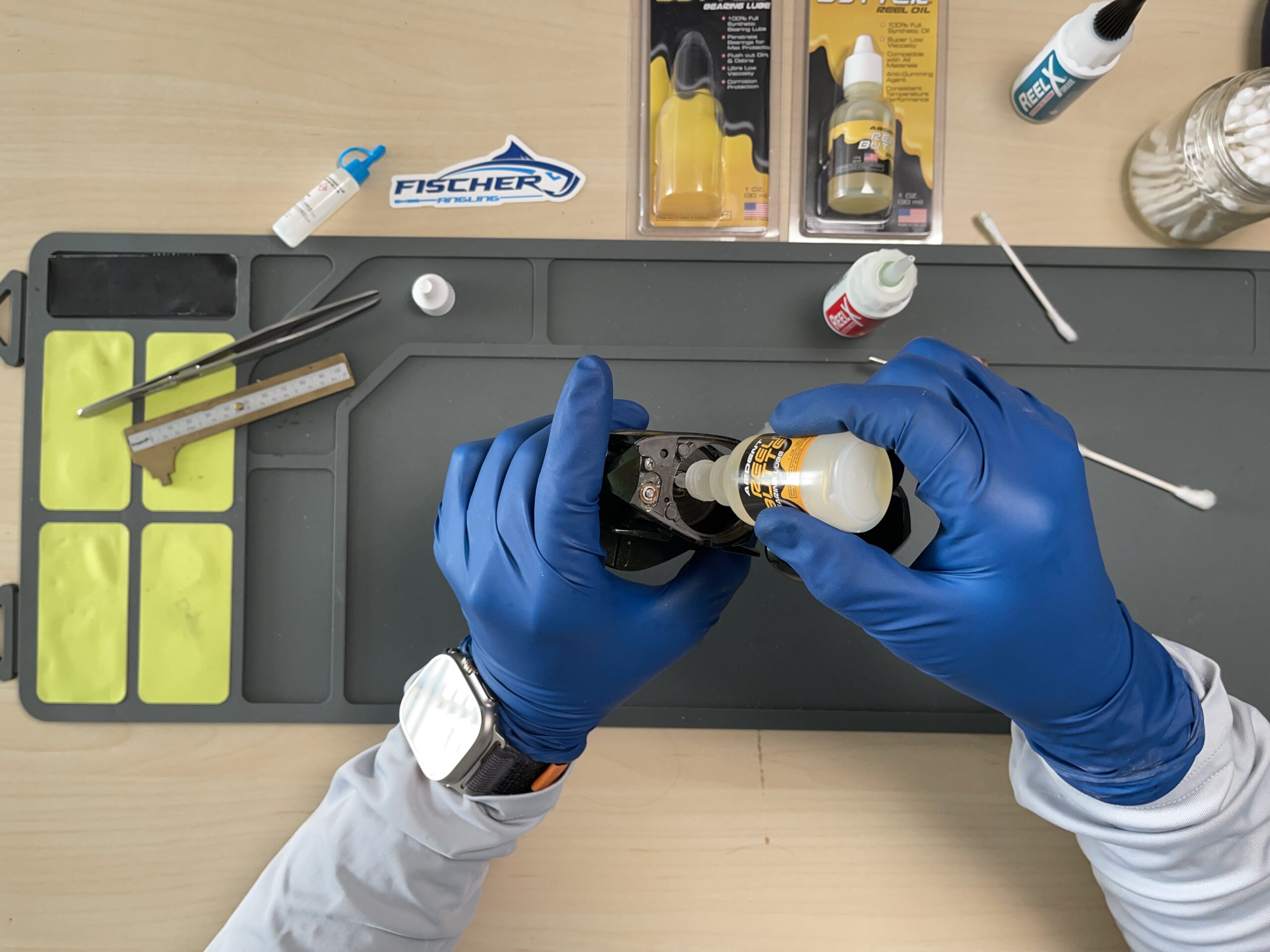
Lubricating Additional Reel Components
At this point, you can oil the spool tensioner bearing. First, remove the spool tensioner knob, which sits a little behind the reel handle.
CAUTION: Unscrew the knob slowly. Some reels have springs inside that can fly out.
Once the knob is off, you should be able to see the spool tensioner bearing. Lubricate it with a drop of Ardent Reel Butter Bearing oil or ReelX Oil. Then replace the spool tensioner knob.
The next step to properly lube a baitcast reel is the worm gear. As you turn the handle of the reel, the worm gear moves the line back and forth to ensure that the line winds evenly onto the spool. The worm gear is located at the front of the reel and is attached to the line guide. Since the worm gear doesn’t rely on spinning ultra fast, it needs a less viscous type of oil to keep it running smoothly, like Ardent Reel Butter or the ReelX multi-purpose oil. Both are a little less viscous and will adhere to the worm gear longer. Turn the reel handle slowly as you apply 1-2 drops of oil directly on the worm gear. Keep turning the handle 15-20 times to allow the oil to cover the entire worm gear. Some people apply a mixture of oil and reel grease here. However I like to use only a multi-use oil on the worm gear as I find build-up can occur when grease is added. I recommend lubricating the worm gear every 3-4 trips.
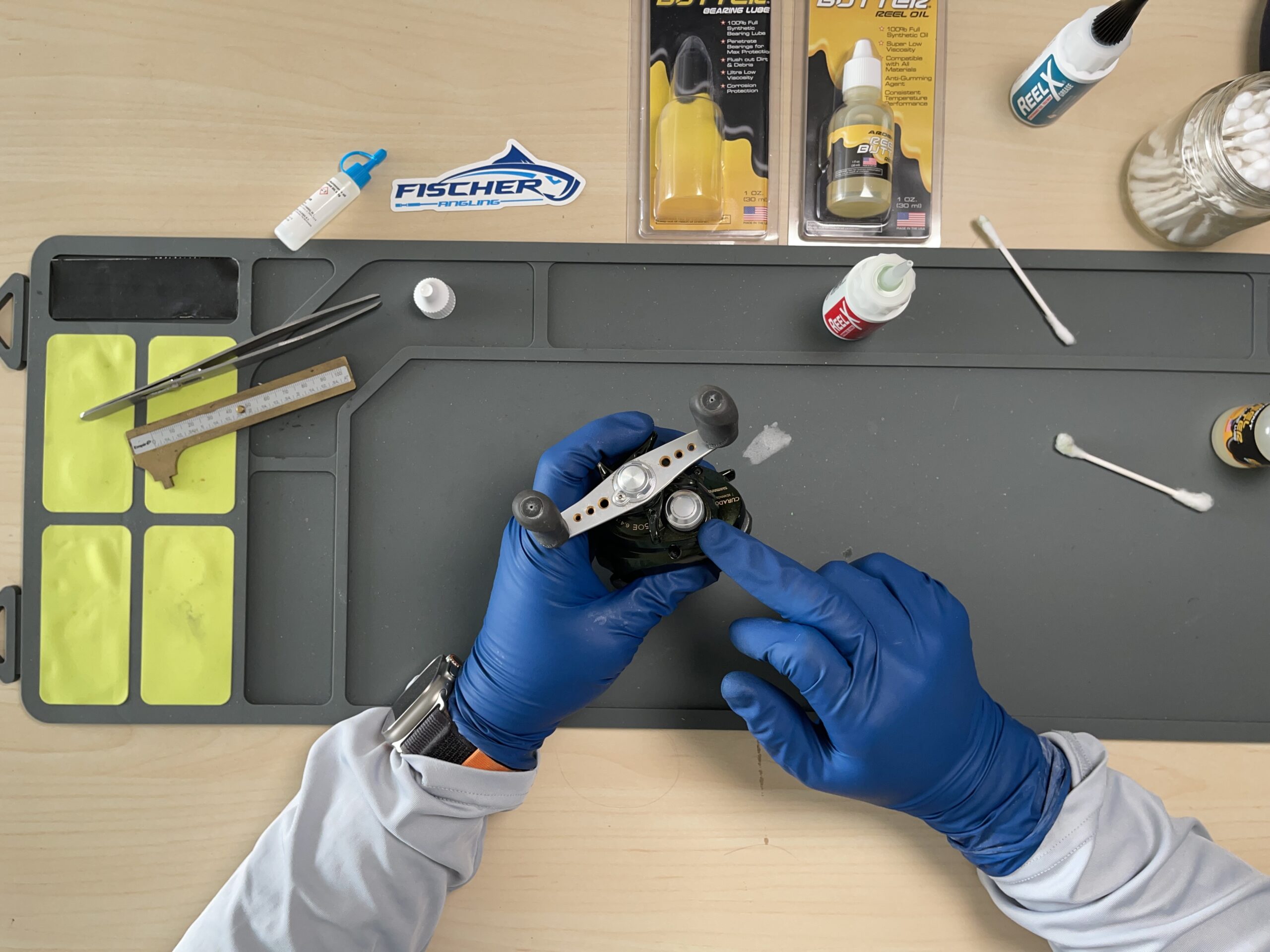
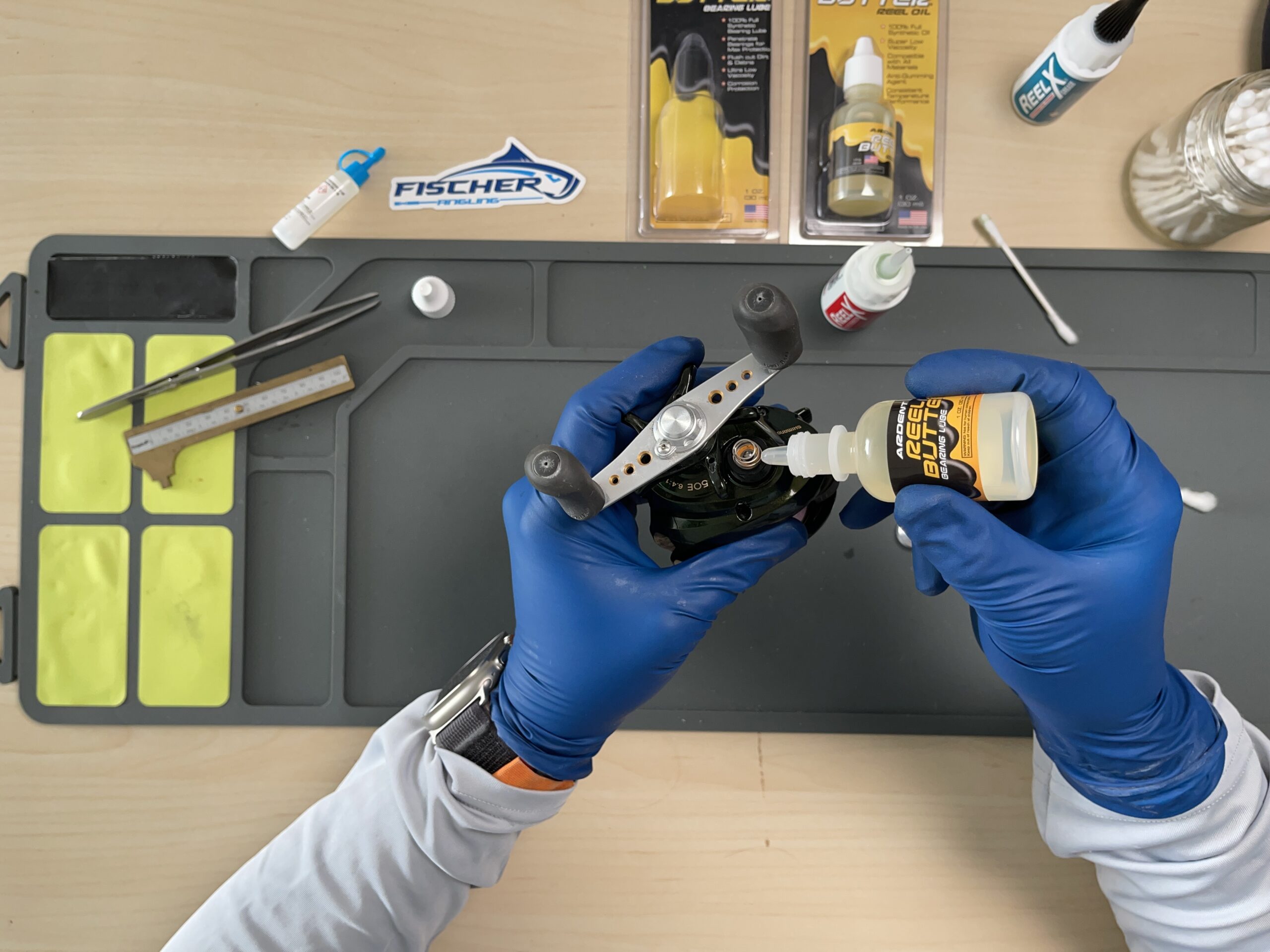
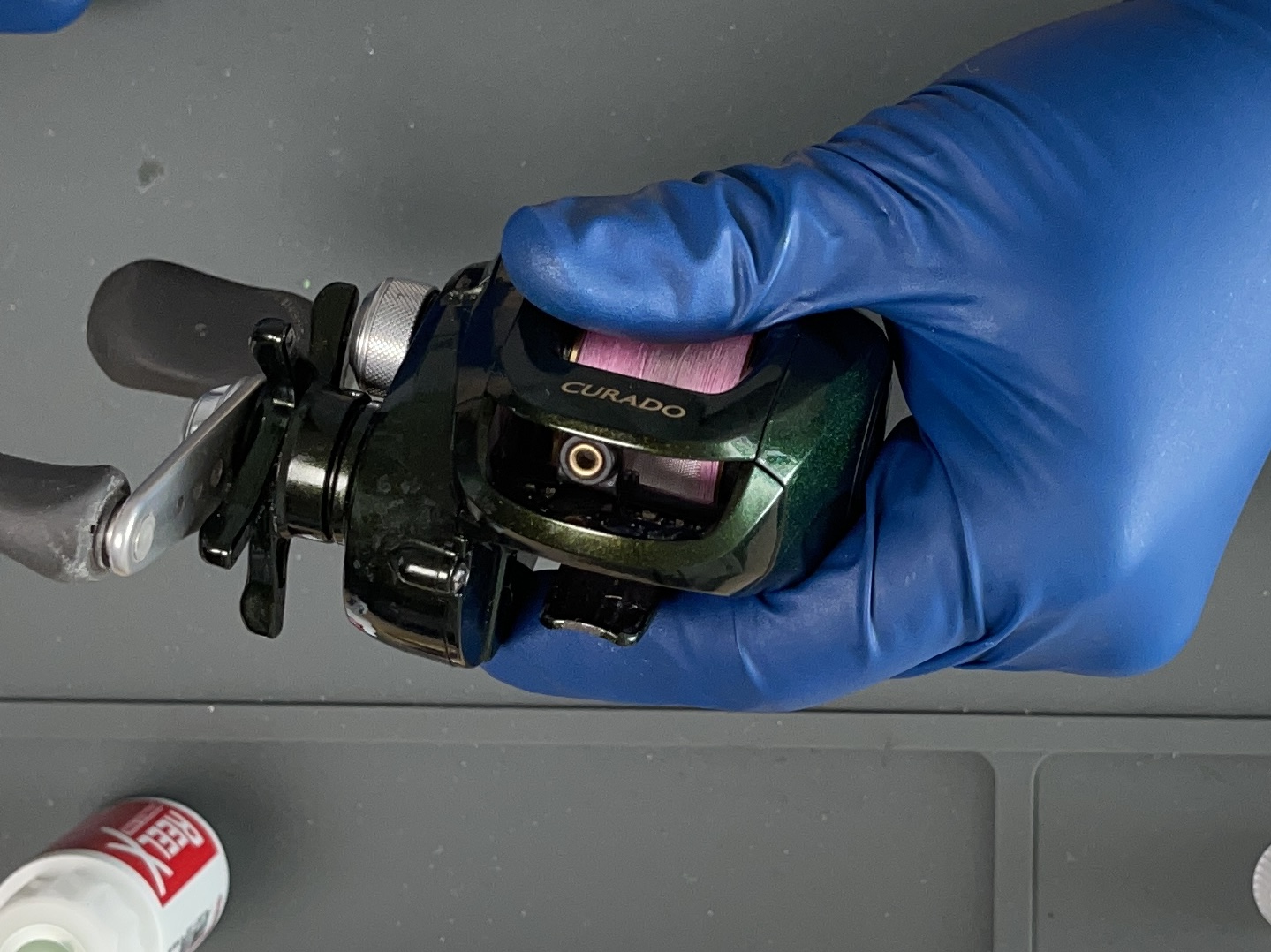

Although we’re not oiling many internal parts, there is one more area that you can oil if you’d like. These are the handle knobs, which also contain bearings. In my experience, I can tell when the knobs have been oiled because the reel just seems to operate smoother. So I recommend doing this every 5-10 trips just to keep the handle knob bearings from seizing up. To properly lube a baitcast reel, apply Ardent Reel Butter or ReelX on the handle knobs because these bearings are less vital to casting. To oil the reel knob, just place a drop of oil where the knob meets the handle. You do not have to remove the outer knob plug as that screw is only for removing the knob itself. Just adding a drop of oil on the knobs and turning the handle a few times is sufficient.
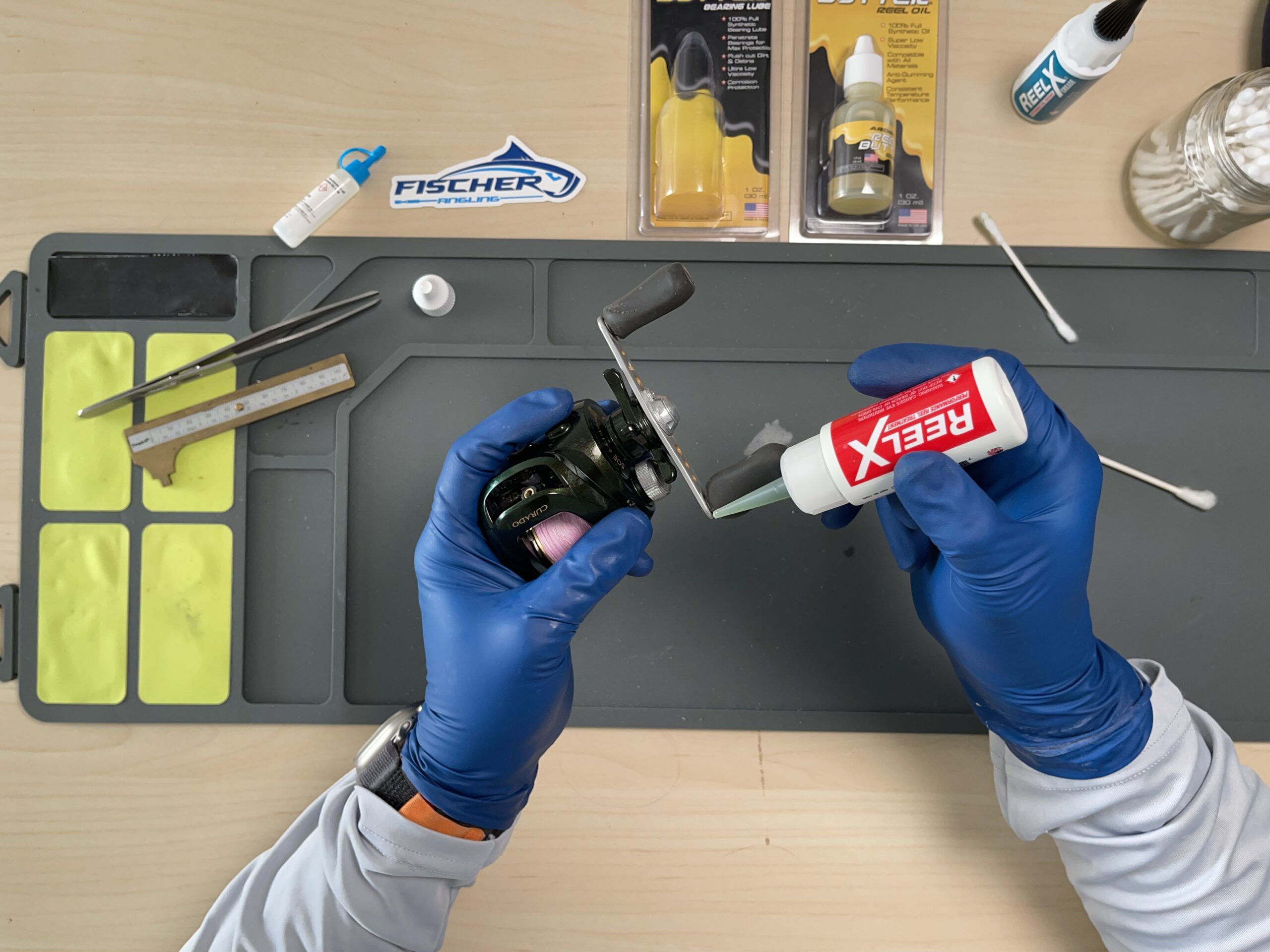
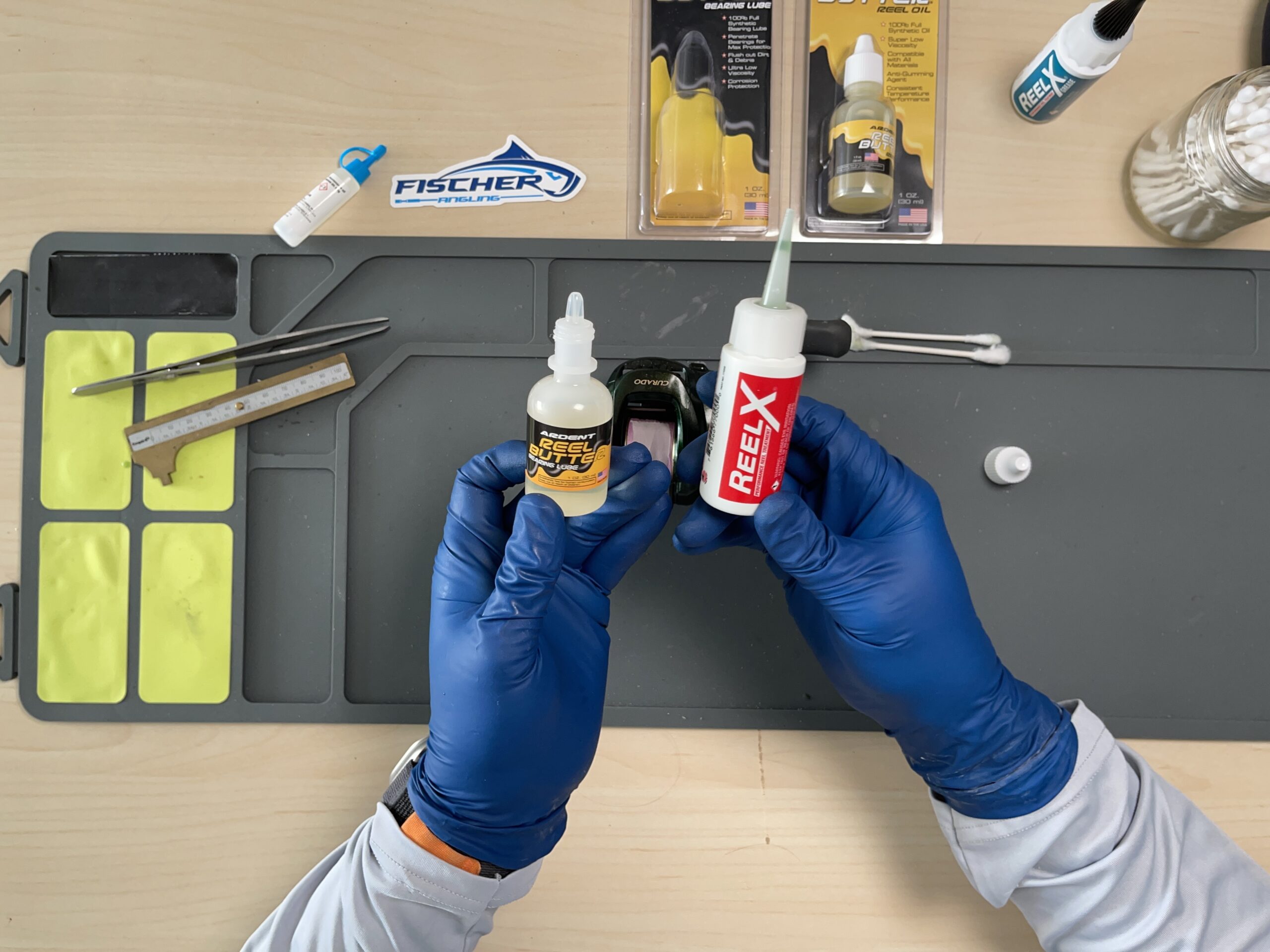
Conclusion
This might seem like a lot of work, but with practice it will become easier and quicker. I make it a habit to perform this maintenance at the recommended intervals I've suggested. When I do skip a step, I notice that the reel just doesn’t feel right. For me, having properly working reels when out on the water makes the trip much, much more enjoyable. I hope that this article has helped you understand how to properly lube a baitcast reel. Also, please remember that to keep reels in top performance, they need a professional servicing at regular intervals. Please click on the link below which sends you to my baitcast maintenance ordering site. Be sure to order reel maintenance for any reels that need it!
Thanks again keep those lines tight!
Chris Fischer
Senior Fishing Correspondent/Owner
Fischer Angling, LLC
[email protected]
www.fischeranglingpro.com
My recent blog titled ‘How to Properly Lube a baitcast reel’ found me inundated with readers asking me how to properly lube a spinning reel. Spinning reels are much different than baitcast reels and have fewer parts that need to lubricate. Their simplicity and ease to master are a couple reasons they are so popular among anglers. I won’t take the reel completely apart in this article but will show key areas where spinning reels need lubrication. A proper lubrication on your reels, between regular professional services, is going to keep your reels in top working order.
Types of Reel Servicing Lubricants
There are many different manufacturers and types of fishing reel lubrication products out there. There are also times when you want to use one over there other. I will simplify this so you know twhat lube to use and when. Now I’m a fan of Ardent reel servicing and reel maintenance products. I’m not an affiliate with Ardent so I’m still an unbiased party. In my blog, How To Maintain and Store Your Fishing Reels Between Trips, I recommend Ardent’s Reel Guard keep the reel safe from corrosion. Ardent Reel Guard is designed for both salt and freshwater reels. Please take a look my blog for more information. Besides just the Ardent brand, there are other great manufacturers out there and I'll note these below. The main thing to understand is how and when to use these different lubrications.
What to use:
Ardent Reel Butter Bearing Lube
Aardent Reel Butter Oil, Multi-use
Shimano Bantam Oil
ReelX Oil - Multi-use
ReelX Grease
SpeedX Oil
Cal’s
What not to use:
WD-40 - I can remember the first time I inhaled that sweet smell of WD-40. I was a kid ‘oiling’ my bike chain and was so happy with how nice and smooth it made the chain. Unfortunately, WD-40 is actually a degreaser that breaks oils down. WD-40 has some great uses but don’t use it on your fishing reel.
Graphite - Graphite doesn’t work on reels or bearings that need a liquid lubricant. Plus it’s messy and gets everywhere.
Lubricating the Reel
So now that we know a couple reel servicing lubricants, I’ll take you through which one of them to use to properly lube your spinning reels. I'll also run through the lubrication frequency for spinning reels and fishing styles.
The first area that I lubricate on a spinning reel is the handle. I take the handle off the reel and place a couple drops of Ardent Bearing oil in each bearing hole. Try not to put too much oil in this area as it causes build up and can decrease the smoothness of the handle. It’s tempting to take the side panel off the reel and take a look inside, however I don’t recommend doing this unless you’re very familiar with the inner workings of the reel. Some of the reels I receive started with a curious angler and ended in a box of parts. So I recommend leaving the full reel servicing to a professional as we know these reels inside out and will warranty any of the work done. Once done, put the handle back on the reel.
The next step in how to properly lube a spinning reel is the spool. The spool on a spinning reel is very easy to remove. I recommend taping the line down so you don’t have a birds nest of line all over your workspace. Use bandage tape as it’s easy to tear into smaller pieces and sticks to just about anything. I even use it on my spools of new line when storing. Once you have the spool off place a drop on the shaft and put the spool back on, pretty simple.
The next area that I lubricate are the two bail attachment ends. Make sure the bail is opening and closing smoothly as a stuck or rough ball roller can cause the line to twist. When line twists on the spool it causes what we call wind knots and makes the casting experience a nightmare.
The last step in how to properly lube a spinning reel is the handle knob. This is something that anglers often overlook in the process. You can tell a difference with a handle knob with regular oiling compared to one that is corroded or tight. On most reels there’s a bearing in the knob that needs oil. Place a small drop of oil on the area where the knob meets the handle arm.
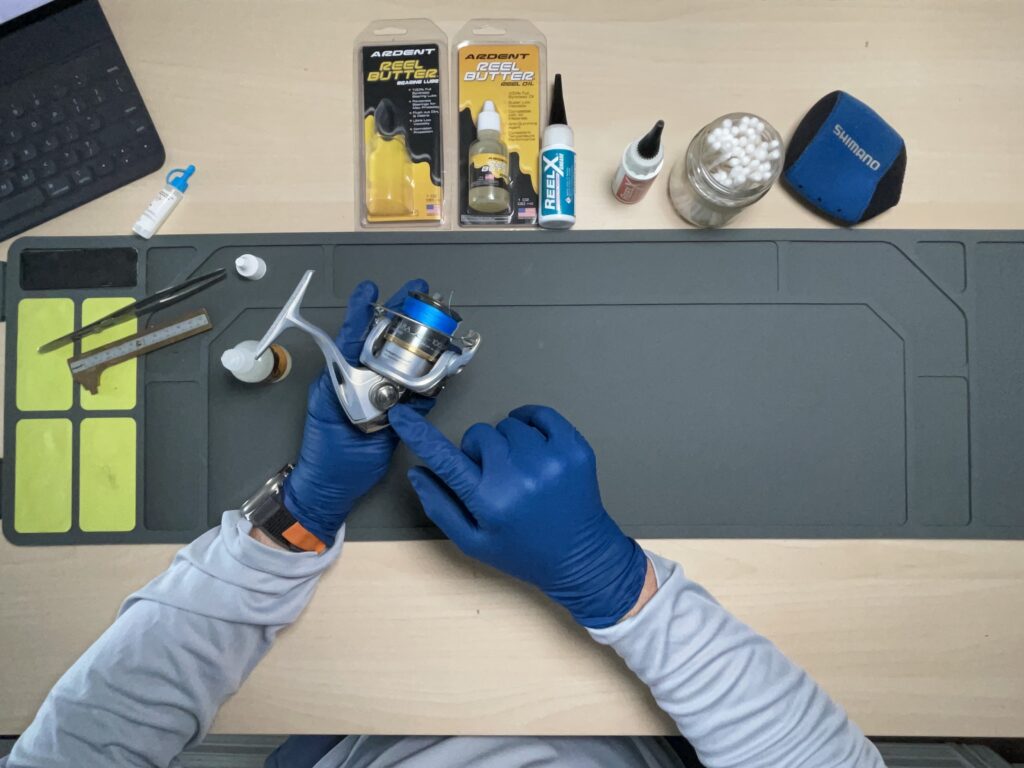

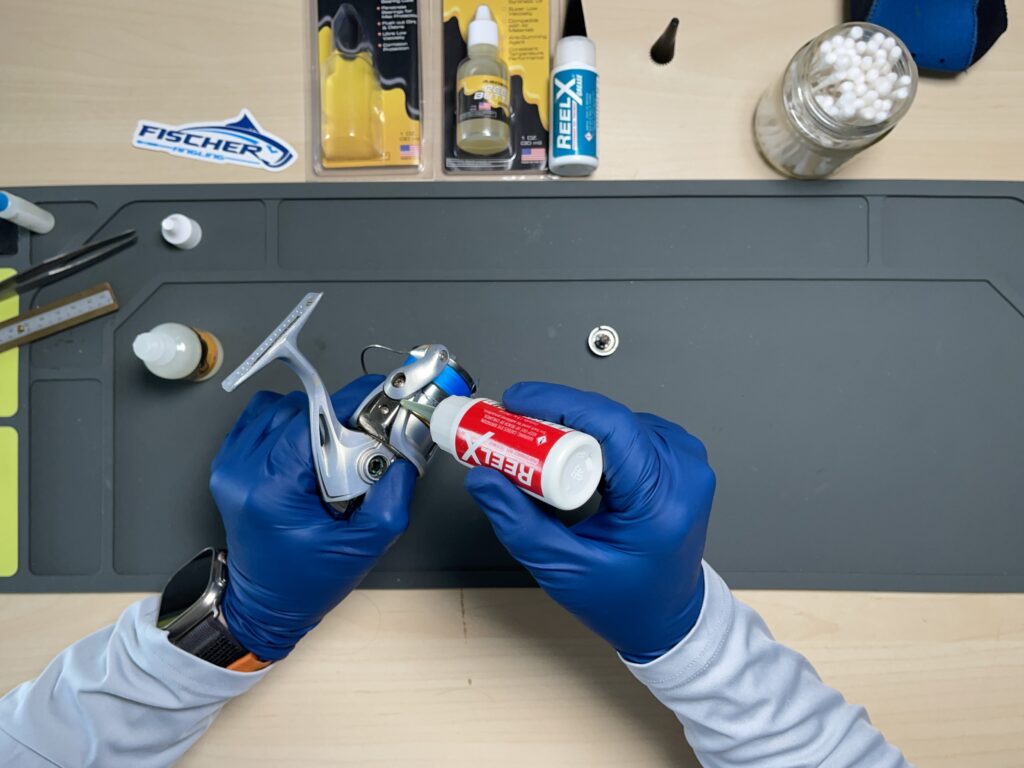

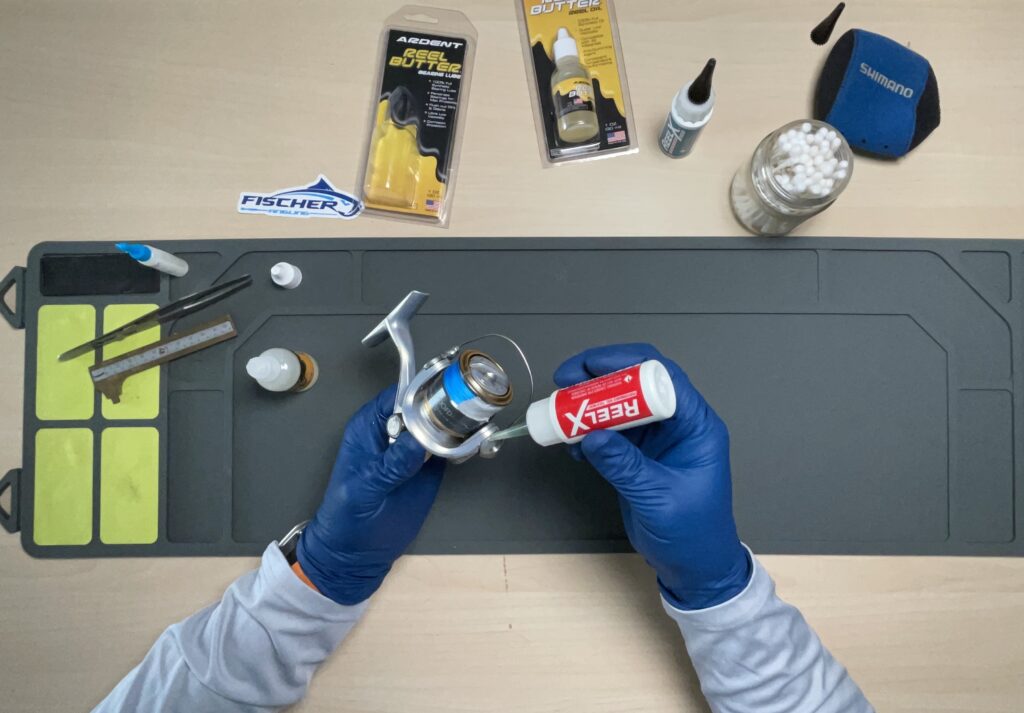

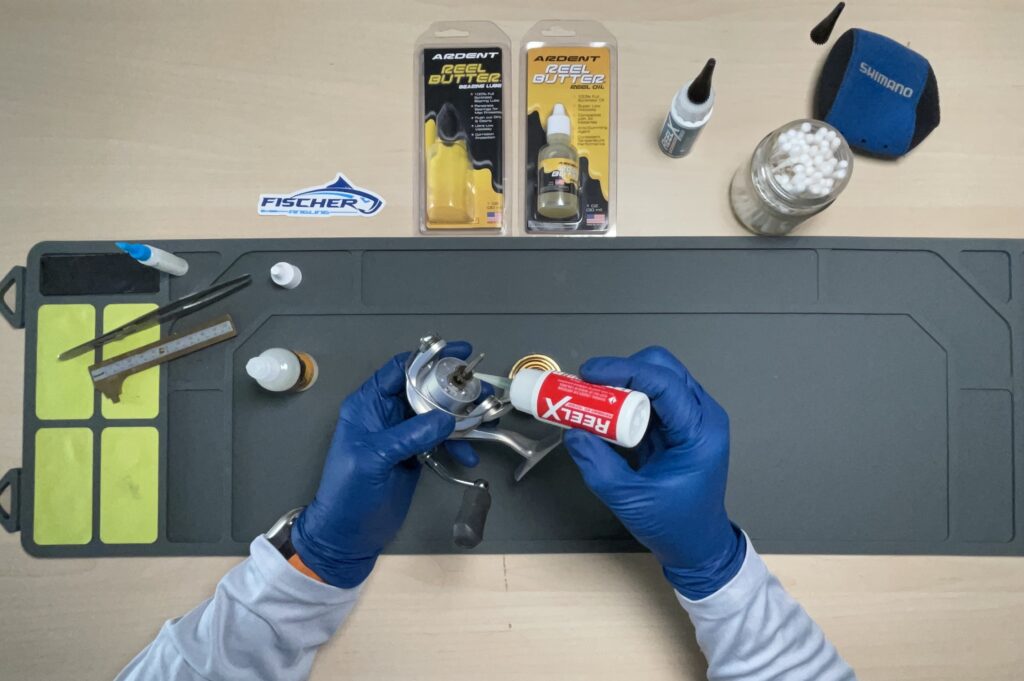

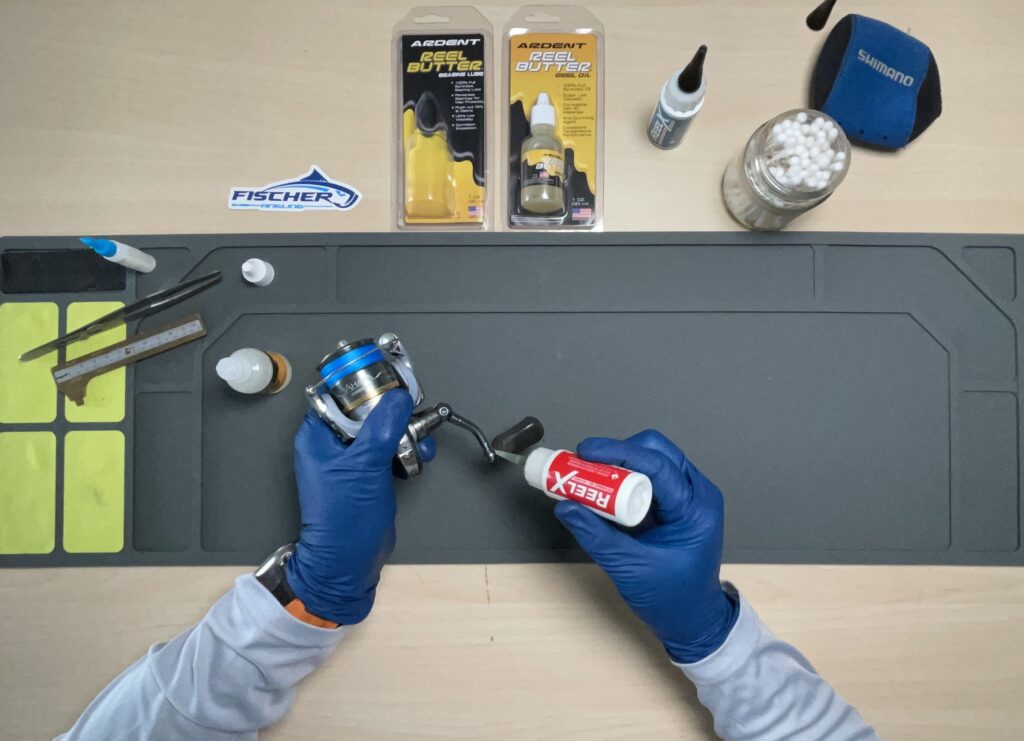
Spinning Reel Maintenance Ports
Some reels are equipped with an oil injection maintenance port in the side plate. I personally don’t like these and manufacturers have been removing them on most of the newer reels. This is for a couple reasons: 1) to keep the reel watertight, 2) the maintenance ports tend to be over oiled by many anglers and, 3) the internal parts need both grease and oil. So putting a drop of oil into an area that needs grease creates a mess. I don’t suggest opening these ports at all. It's best to wait for a full professional service for the internal parts to be properly oiled and greased.
How Often Do I Lube my Spinning Reels
I perform the steps in how to properly lube a spinning reel basic maintenance procedures at least once a week if I’m in freshwater and after every second fishing trip for saltwater. This quickly became a habit for me and I know has kept my reels in great working condition. I very rarely, if ever, have a reel out of commission due to an equipment failure. It’s something you will get much better at and that will become second nature.
Conclusion
I hope that this How to Properly Lube a Spinning Reel article helps you locate the key components on a spinning that need lubrication. Please remember that keeping a spinning reel in top performance will only happen if you also have a regular full professional service. Fischer Angling helps you with all your fishing needs and with any questions that you might have. Please feel free to reach out to me.
Thanks and keep those lines tight!!
Chris Fischer
Senior Fishing Correspondent/Owner
Fischer Angling, LLC
[email protected]
www.fischeranglingpro.com
A question many people ask me is, “Is it worth it to replace my old reel with a new one or to have it repaired?” One item I’ll point out is that regularly scheduled reel service is different from a true reel repair. All reels should be regularly serviced, but not all reels should be repaired. There are many reasons to keep an older fishing reel; nostalgia or a family connection to the reel, the reel still performs great when it’s clean and the replacement cost of a quality reel can be high. In my blog, How to Choose a Quality Baitcast Reel, I explain the components you want to look for when choosing and buying a quality reel. The reels I’ve recommended in that article are built by major manufacturers and cost anywhere from $80 to upwards of $300. If you’re buying one of these reels I would recommend having them serviced regularly and making necessary repairs versus replacing them.
The buy a new reel or repair old reel question starts to get more complicated when a reel hasn’t been serviced regularly, might have some type of damage, isn’t a quality reel in the first place or isn’t in all that great a condition. There are three questions I ask a customer when they bring this up to me: 1) Does the reel have nostalgic value? Was this Grandpa’s reel that he gave you when you were a kid? 2) What type of damage does the reel have? Most reels can be salvaged with some elbow grease and new parts. The older reels might have hard to find components but for the most part you can always fix a reel. 3) What is the original cost vs. replacement cost? Was this an expensive reel or was it a lower-end reel that can be easily replaced. Those are the questions you’ll want to consider when/if this situation comes up (which it frequently does).
With the advent of Amazon, eBay and online shopping, there are many more fishing reels to choose from, all at different price points. To buy a new reel or repair old reel becomes less of a question especially when reel prices plunge below the $50 level. Because of this I’m seeing more customers who have purchased off-brand or quite possibly inferior reels ask if they are worth repairing. Again, I’d first suggest reading my blog, How to Choose a Quality Baitcast Reel, to find a quality reel. However, many of us are curious about these reels and because they might be lower in cost we take a chance and buy one of them. It wouldn’t be fair to make a blanket statement saying they are all inferior. I can say that most of these reels haven’t been subjected to the rigorous testing that the major manufacturers put their reels through. But the question still remains; are these reels worth repairing or replacing? Well, like any reel they are still needing regular servicing. Any reel will fail without it. But if your reel was less than $50 USD I would suggest replacing it with a quality reel. Most repairs, along with a regular servicing, will cost more than $50. So save your money for a higher quality reel, have it serviced regularly and you’re going to be much happier in the long-run.
So what items would be considered ‘Fixable’ vs. ‘Not Fixable’?
Reels can be finicky, especially baitcast reels, and in most cases can be easily fixed. Baitcast reels are notorious for having small parts either fail or get out of alignment. It’s a big problem when you’re out on the water and a reel stops working. But many times it will be a small fix to get it back up and running. I’ll give some specific problems that occur with reels so when you come across these you’ll have a better idea as to what is going wrong.
Troubleshooting Baitcast Reels
Troubleshooting Spinning Reels
Spinning reels are less likely to experience problems than a baitcast reel. There are a couple reasons for this. A spinning reel has less moving parts and is an overall simpler design. However, without proper servicing a spinning reel can experience as many problems as with a baitcast reel.
Conclusion
As we’ve discussed in this article there are many factors at play with the question of whether ro buy a new reel or repair old reel. Most reel problems can be fixed, but in some cases the time and money to fix these problems makes it just not worth it. Purchasing a quality reel and having it serviced regularly should eliminate 90% of the problems you’ll have with a reel. When you do have a problem, asking yourself the questions above will help in your decision to buy a new reel or repair old reel. Please remember that Fischer Angling is dedicated to helping you through any of these issues to quickly get you back on the water. Thanks again and keep those lines tight!
Chris Fischer
Senior Fishing Correspondent/Owner
Fischer Angling
[email protected]
www.fischeranglingpro.com
When searching online or at your favorite sporting goods store it can be a somewhat daunting task to choose the right baitcast reel for your fishing needs. With so many manufacturers, colors, styles, sizes, gear ratios and a vast array of prices, it can get confusing to most people. I’m going to guide you through this process to help you choose a quality baitcast reel that fits all your requirements.
To choose a quality baitcast reel, you don’t always need the most expensive reel out there. More often than not, the difference between a $100 reel and a $500 is actually very small. As reel prices increase, the differences between them become less and less apparent. So what are these differences and what do you need to pay attention to when purchasing a baitcast reel. The big differences between baitcast reels occur in four main components:
In this article we’re going to take you through each of these so you’ll have a good idea as to what you’re going to want to look for in a quality baitcast reel.
Manufacturer
Choosing the right manufacturer can quickly turn into a heated debate. Just like with automobiles, most anglers prefer one particular manufacturer over another. Most major manufacturers are going to have longevity and good reputations, which means that much of the choice comes down to personal preference. I suggest a major manufacturer versus a lesser-known manufacturer when selecting your baitcast reel. Remember that with a major manufacturer you are going to spend a little extra on your reel, but you will have peace of mind knowing they have been standing behind their products for a very long time.
Body Style
There are several different styles of baitcast reels out there to choose from. For this article, we’re talking about two types of fishing:
When it comes to body styles in this group you’ll see either a traditional round body or the low-profile body.
Round Body
The round body style is going to be the heavier of the two styles and will be made up of aluminum, stainless steel and plastic components. These reels are great if you’re bait fishing or jigging where extra weight might not be a concern. They are also some of the most durable reels out there and can easily be taken apart for maintenance and service. You'll see a lower bearing count in these reels because they are less complicated.
Low-Profile Body
The low-profile style of reel will be lighter in weight and generally made from composite materials. Low-profile reels are more difficult to take apart and are more finicky than a round body reel. However, if you’re on the water all day making hundreds of casts, then you will appreciate the lighter weight reel. Low-profile reels are also consistently more accurate which is much needed when casting to reefs, around trees and sight fishing.
Here are some pros and cons for both:
Round-Body
Pros:
Cons:
Low-Profile
Pros:
Cons:
The type of fishing you’re going to be doing will help when making a decision about which reel body style you choose.
Bearing System
The amount of bearings in a particular reel has always been a bragging point for many manufactures. They feel they can charge more for a baitcast reel if they jam more bearings into it. It's a component that plays a big part in the decision most consumers make when purchasing a reel. Who wouldn’t want to buy the reel with 8 bearings over the one that just has 6. Unfortunately, bearing count doesn’t always equate to longer casts or a smoother reel. Bearing count just tells you that there are more bearings in one reel vs the other. The other side to this is the quality of the bearing used in the reel. In many cases, a less expensive reel with better bearings can outperform a much more expensive reel with sub-par bearings. Don’t always get hung up on the bearing count. You can either upgrade the bearings after purchase or pick a reel with high-quality bearings to start with.
Braking System
The next item to look at is the type of braking system that the reel has. The main purpose behind a braking system is to control the backlashes that often occur with baitcast reels. A backlash happens when the spool is turning faster than the line leaving the reel. This leaves us with a tangled mess of line around the spool. The job of the braking system is to slow the spool so that the amount of line leaving is consistent with the rotation of the spool.
There are 3 standard types of braking systems out there:
I’m not going to go into the detail of all these as that would take an entire article. However, each of these have their unique differences that you’ll want to make sure you research before buying a reel. I have two braking preferences for all the reels I use and that is the centrifugal and digital variety. I like the centrifugal brakes because they are very easy to maintain. I like the digital braking systems because they are phenomenal when casting into the wind.
Reel Recommendations:
Now that you’re armed with the information needed for choosing a reel the next step is to find the reel for you. The reels below are all reels I’ve used, tested, and recommend. I’ve listed them in a couple categories from Beginner to Advanced baitcast experience. These beginner reels start at a lower cost and gradually increase in price to the more advanced reels.
High-quality Low-Profile Baitcast Recommendations:
Beginner:
Shimano SLX
The Shimano SLX is a beginner reel that I chose because the price is great and Shimano puts out some nice reels. This one
Abu Garcia MAX Pro Low Profile Reel
Advanced:
Shimano Chronarch MGL
Shimano Curado MGL 70 K
Abu Garcia Revo STX-HS Low Profile Reel
The Abu Garcia Revo line is a little different in how they advertise their gear ratios. There are three choices for this reel in the right-handed model. The STX is a 6.6:1 gear ratio | STX-HS is 7.3:1 | STX-SHS is 8.0:1. As with all these advanced reels you will want to pay attention to the gear ratios which works for the fishing that you're doing at the time.
High-quality Round Baitcast Reel Recommendations:
Beginner:
Abu Garcia Ambassadeur S
Daiwa Millionaire Classic
Quantum Nova
Shimano Cardiff 200
Advanced:
Shimano Calcutta Conquest 100
High-quality Digital Reel recommendations:
Shimano Curado DC
Shimano SLX DC
Conclusion
One thing to remember when you choose a quality baitcast reel is that not all reels are perfect. There are specific reels made for specific types of fishing so it's not easy finding just one reel to fit everyones needs. But I hope that I've armed you with some great information to help make your decision easier.
Thanks so much and keep those lines tight!
Chris Fischer
Senior Fishing Correspondent/Owner
Fischer Angling
[email protected]
www.fischeranglingpro.com
Many of us want more casting distance or more drag control from our reels. You can get both of these from your existing reel, if you will follow these tips to upgrade your baitcast reel. First, make sure you have a quality baitcast reel. Second, regularly maintain your reels before and after each fishing trip. Finally, have a complete, professional reel maintenance performed on a regular basis. This will give you a baseline to decide whether your reel has mechanical issues or whether it’s performance is maxed out.
So, let’s say that your reel is in great working condition and that all these conditions have been met, and you still want better casting distance and more drag control. This is when you want to upgrade your baitcast reel with superior aftermarket components. Four components to upgrade in a baitcast reel are Bearings, Drag Washers, Braking System and a Full Super Tuning service.
Ceramic Bearings
The biggest question everyone has is whether ceramic reel bearings are worth the trouble and expense. To answer this question, you need to consider a couple of things. The first is how you use your fishing reels. If you rarely wash your reels and don’t care about casting distance or how smooth your casts are, then the answer is no, ceramic bearings won’t be important or worth it to you. If you maintain your reels religiously and want a smoother longer cast then the answer is yes, absolutely, as ceramic bearings make a huge difference in performance and are worth it. The second part to this answer is focused on your reel’s longevity. Is it important for you to have bearings that are extremely durable and that will last upwards of 10 times longer than a traditional stainless bearing? If you’ve answered yes to both these questions then you will want to upgrade your reel with ceramic bearings.
I install ceramic bearings in all my personal casting fishing reels. I install them at the spool level, which means I may install 2-3 bearings per reel. I typically don’t install them in the handles or any internal part not associated with the spool. The reason for this is that I’m only looking for a cast that is super smooth and gives me extra distance. If you’re looking for an even smoother performing reel, then you can upgrade all your bearings to ceramic but that gets expensive and might not be worth the cost.
Bearing components within a fishing reel: Fishing Reel Bearing Basics
Bearing Outer Components
Bearing Internal Components
Bearing Rating System: ABEC Ratings
Many bearing manufacturers make all types of claims about their high standards and the high quality of their bearings. But how do you really trust these claims? To address these types of claims, bearing manufacturers have set standards for quality control and bearing precision. The three main rating bodies are as follows:
Here in the US, we use the term ABEC for our bearings and all manufacturers importing their bearings must adhere to these standards. The higher the ABEC rating the higher the bearing quality. The ABC Ratings are:
ABEC 1, ABEC 3, ABEC 5, ABEC 7, and ABEC 9.
ABEC 7 bearings are the highest rated bearing for a fishing reel that is affordable. ABEC 9 bearings were originally created for governmental organizations like NASA and the Department of Defense. If someone claims their fishing reel bearings are ABEC 9, they are more than likely misrepresenting them because ABEC 9 are so rare and so expensive that they make no sense in using in a fishing reel. All Fischer Angling ceramic bearings are ABEC 7 ceramic hybrids.
Ceramic vs. Stainless
Ceramic reel bearings come in a couple of types; full ceramic and ceramic hybrids. A full ceramic bearing has completely ceramic outer and inner races, while a ceramic hybrid has stainless outer and inner races. Both full ceramic and ceramic hybrid have ceramic balls. Full ceramic bearings are very expensive and are not commonly found in fishing reel applications, so for the remainder of the article when I say ceramic I mean hybrids. Stainless bearings have all stainless components, including the inner and outer race as well as the balls.
The advantages of ceramic bearings are that they hold up better to corrosion than traditional stainless bearings. Also, ceramic bearings are lighter, however this is such a small difference that it’s hardly worth mentioning. Finally, the main advantage is the ceramic ball itself, which produces much less friction than its stainless counterpart. Less friction allows the ceramic bearing to spin faster which results in the spool spinning faster. That is where you will get the added smoothness and up to a 20% increase in casting distance from your reel.
Carbon Fiber Drag Washers
Fischer Angling installs Carbontex carbon fiber drag washers, the highest rated material for fishing reel drag systems. Tough and almost impervious to heat, Carbontex is a quantum leap over the brittle paper washers fitted to so many factory fishing reels.
So what is Carbontex?
Carbontex is a type of woven carbon fiber sheet. These sheets are generally .3mm to 1mm in thickness and can be cut to almost any size or design. Carbontex fiber sheeting is used in many industries for a variety of applications. Carbontex is strong, stands up to heat and is lightweight.
Carbontex has many advantages such as:
Which reels would benefit from carbon fiber drag washers drag washers?
All fishing reels contain some type of internal drag systems. Spinning, casting and offshore trolling reels all use a drag system and can be improved with carbon fiber drag washers. Some reel manufacturers use better materials for their drag washers than others. However most factory drag washers are either paper, felt, or hard plastic. Even some very expensive reels can be fitted with sub-par drag washers.
Why are they used for fishing reels?
When used in a fishing reel drag system, carbon fiber drag washers are much smoother in operation, more reliable, more durable, and hold up much better than any other drag washer material. For those reasons, Fischer Angling Carbontex carbon fiber drag washers are a great upgrade for your fishing reel. Insert Link?
All these factors translate into a huge upgrade over factory drag washers. They will deliver a much smoother drag with added stopping power. Carbon fiber drag washers deliver up to 20% more drag power than factory installed washers. They also help eliminate sticking drags that can cause line breakage.
If purchasing from our website you can add these to your order and we will install them with no installation charge. We can also ship these directly to you to install at your convenience.
The Braking System
Another important area addressed with the super tuning reel service is the centrifugal brake system. The braking system on a baitcast reel will normally consist of 4 to 6 collars that can be adjusted by snapping them in or out. These collars lightly touch the outer spool housing when you are casting by using centrifugal force that slows the spool down. If the outer spool housing has any rough spots or is corroded, the collars will bounce around. This is another area where irregularities will affect the speed of the spool. As these collars hit these rough areas, you’ll see a decrease in speed which then causes a decrease in casting distance or more frequent backlashes. Note: If your reel has a magnetic braking system, super tuning will not improve performance. Magnetic braking systems do not use these brake collars.
Full Super Tuning Service
A professional Super Tuning will take your baitcast fishing reel to another level of performance. Ever since people have been throwing a line into the water, they’ve wanted to find better ways to get line to the fish with more distance, greater accuracy and with less work. Super tuning takes a traditional off-the-shelf baitcast reel and turns it from a good reel into a great reel. It’s like upgrading a car to make it faster.
Our Super Tuning service includes the Bearings, Spool Shaft, Braking System and Drag System. Don’t be fooled into a high-priced reel super tuning service if all four of these aren’t addressed. We’ve touched on both Ceramic Bearings and Drag Washer upgrades. Now we look at more fine tuning of your reel’s Spool Shaft and Braking system.
The Spool Shaft
The spool shaft has three points where friction occurs The first two friction points are the spool shaft ends and the third is a small area that runs through the pinion gear. Our Super Tuning reel service polishes these three points to a smooth, mirror-like finish, removing all corrosion, divots, and scratches that hinder the reel’s performance.
When the spool shaft friction points are polished, you will get much better control and consistency with your casts. If the spool ends are rough or the pinion gear is scratched or dirty, the spool can catch on rough spots thereby spinning inconsistently. When casting, these small irregularities can create speed changes in the spool. These small speed changes then cause slight hitches when you cast, which in turn decreases your distance, consistency, and accuracy. You can tell when you have spool shaft problems when your casts become consistently shorter or you get frequent backlashes. When these happen, you might want to consider having a super tuning service performed on your reel.
The Braking System
As pointed out above, a centrifugal braking system will consist of 4-6 collars that lightly touch the inside of the outer spool housing. With a Super Tuning service we will polish this spool housing to remove any irregularities that can cause these brake collars to skip or slow down. This is a very fine adjustment but when added to all the other components it will make a difference in your casting returns.
Conclusion
When you upgrade your baitcast reel, described above, you'll experience improved casting distance, better stopping power, and an overall better smoothness to the reel. Please remember though that with improvements like these, you will to take steps towards caring for your reels. This is something you can easily do yourself by following the steps in my How To Maintain and Store Your Fishing Reels Between Fishing Trips blog. Here at Fischer Angling, we perform all these upgrade services for your reel. We’ve vigorously field tested all the upgrade components we sell and guarantee them to be the highest quality on the market. If you have any questions, I’d love to hear from you so please feel free to reach out to me at any time.
Thanks and keep those lines tight!
Chris Fischer
Senior Fishing Correspondent/Owner
Fischer Angling LLC
[email protected]
www.fischeranglingpro.com
I have a lot of people who come to me asking how I maintain and store my fishing reels, rods and gear between fishing trips. This is an important part to fishing as it’s going to affect your level of enjoyment when you’re out on the water fishing. If you haven’t prepared adequately you’re going to end up with under-performing gear, missing essential tools and just an overall feeling of frustration. I have a process that I try to stick to when preparing for fishing trips. This includes not only the initial preparation but also what to do when your fishing trips end. This article will help to create a process that works for you that will improve the overall quality of your fishing trips.
Preparation
Not many of us like to prepare their fishing equipment the night before a fishing trip, however taking these simple steps can help stop most headaches when you go out on the water. Make sure all your reels are in working order and ready to go by doing the following:
Cleaning and Storing Between Uses
There are several different types of saltwater fishing styles: 1) Boat fishing 2) Surf Fishing 3) Pier fishing 4) Wade fishing. Wade fishing and Surf fishing require additional steps that I will outline in a section below.
When you take your rods off the boat or out of your car and are ready to store them here are some tips on what to do. These steps apply to all types of fishing that you do.
General Cleaning and Storing Tips
Wade and Surf Fishing
Boat and pier fishing are the easiest types of fishing when it comes to cleaning and storing your rods/reels between use. This is mainly because your rod/reel is not typically going to come into direct contact with saltwater which has corrosive minerals, and perhaps sand and grit. These two types of fishing use the basic steps to cleaning and storing your reels. Wade fishing and surf fishing, however, have additional steps that are covered below.
In addition to the steps above, I recommend the following when wade fishing and surf fishing. When back onshore or back in your boat, take a clean, wet towel (with freshwater) and wipe down each rod/reel you’ve used. Both wade fishing and surf fishing cause a large amount of saltwater to build up on a rod/reel even after just a dozen or so casts. I recommend wiping these down before moving from one location to another or even after a couple hours in the surf. In my experience with cleaning, maintaining and repairing reels, this is the #1 cause for a reel to corrode and to need maintenance or repairs. Taking a couple seconds to wipe the rod/reel down immediately after use will greatly cut down on your corrosion or maintenance issues.
Things to avoid or just plain not do
I’ve had people recommend soaking their reels in a bucket of freshwater or some who like to drench a reel with a hose and soap. There are a couple reasons not to do this. Most reels are not watertight. Baitcast reels have holes in them that will allow water to get into the gears and bearings. Spinning reels are a little better in that the interiors are somewhat sealed but they can still get water into them. Some soaps can dissolve lubricants that reels need for protection to work properly. So don’t completely flush a reel with water as it’s going to lead to eventual corrosion and water damage. Also, don’t flush a reel with a hard stream of water that can drive sand and grit into the gears and bearings or use soap on them. Be gentle when using a hose to clean your rods/reels and when you do you will keep them working and looking great!
I hope that you got some useful advice on how to Maintain and Store your fishing reels, rods and gear. Just remember that when you’re out there fishing you’re going to have a much better time with gear that is working properly and is there for when you need it most.
Thanks and keep those lines tight!
Chris Fischer
Senior Fishing Correspondent | Owner
Fischer Angling LLC
[email protected]
www.fischeranglingpro.com